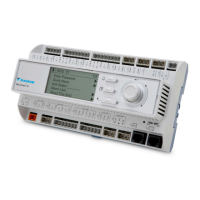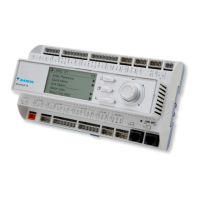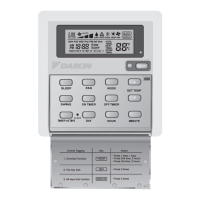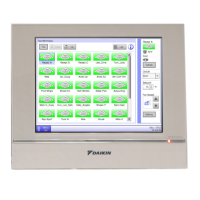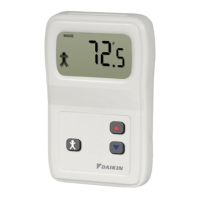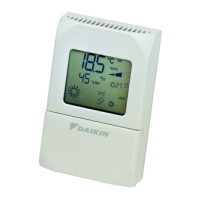62 Daikin IM 696-4
Test Procedures
Troubleshooting Auxiliary Control Boards (CCB1,
CCB2, GCB1, EHB1 and ERB1)
This section outlines basic functional checks of the auxiliary
control bo
ards that might be connected to the MCB via the RS-
485 communication bus interface.
Hardware Check
1
Verify the auxiliary control board has been wired and
terminated properly. Refer to the as-built unit wiring
schematics or refer to Figure 16 on page 38 (DAC units) or
Figure 17 on page 41 (SCC units).
2 Verify the RS-485 Communications module on the
auxiliary control board is properly installed. Verify the
address switches on the RS-485 Communication module
are set to the correct address.
Note – Address switches may “appear” to be set correctly but
actually may not be “seated” well. If there is a
communication problem between the main control board
and an auxiliary control board, try toggling the switches
up and down a couple of times, reset them to the correct
setting, and cycle power to the auxiliary control board.
Refer to Table 4 on page 9.
3 Verify that 24 VAC power is available (CS1 or CS2 switch
ON on as applicable) and properly terminated on the J1
terminal block on the auxiliary control board.
RS-485 Communication Card Status LEDs
A set of two status LEDs is located in the lower right area of
the RS-485 Communication Card mounted on the auxiliary
control boards (refer to Figure 7 on page 11). These LEDs
provide useful trouble shooting information. The upper LED
verifies that the MCB is transmitting data to the auxiliary
control board. The lower LED verifies that the auxiliary
control board is transmitting data to the MCB.
1 The upper LED should always blink at the same rate as the
RS-485 Activity LED on the MCB (refer to Figure 30). If it
is not blinking and the RS-485 Activity LED on the MCB
is blinking, verify the wiring between the MCB and
auxiliary board is free of defects. If the RS-485 Activity
LED on the MCB is not blinking, it is likely the problem is
with the MCB.
2 The lower LED should always be blinking. If it is not,
perform the hardware checks listed above. If these check
out correctly and the problem persists, cycle power to the
entire controls system using the system S1 switch. If the
problem persists, either the MCB has not been downloaded
and configured correctly or the auxiliary control board or it
is likely its RS-485 communication card is defective. Use
the following procedure to isolate the problem component:
a Verify that the MCB download and configuration has
been performed correctly and then cycle power to the
entire control system using the S1 system switch. If this
has been done and the problem persists, proceed to Step
b below.
b Remove power from the control system and replace the
RS-485 communication card on the suspect auxiliary
control board with a properly functioning card. Do this
by exchanging the RS-485 communication card with
one of the other auxiliary control boards on the unit. If
this is done, make sure to change the addresses switches
on the RS-485 communication cards according to Table
4 on page 12. Apply power to the control system and
check operation. If the problem follows the suspect
communication card, the card is defective. If the
problem remains with the suspect auxiliary control
board, it is likely the auxiliary control board is
defective.
Troubleshooting Keypad/Display
Keypad/Display Power Up Initialization
When the keypad/display is connected to the MCB and power
is applied, the firmware in the keypad/display runs a
diagnostic test of its static RAM (SRAM) and also checks the
micro controller ROM for proper checksum. After these tests
are completed, the keypad/display responds to a poll of its
address by the MCB with an acknowledge message to the
MCB. This causes the controller to start downloading display
information to the keypad/display. The keypad is locked out
until the tests and the download is complete.
Note – The keypad/display address is defined by a four-position
dip switch block on the right side of the device. For this
application, all four of these switches should be in the UP
position, which defines address 32.
When the keypad/display is connected to the MCB and power
is applied, the backlight and the red Alarm LED on the display
are turned on. The backlight remains on until it times out (15
minutes after a key press or after power up). During the next 5
seconds, the LCD counts down from 9 to 0 in all 80 character
locations. After the countdown is complete, the Alarm LED
turns off and the display appears as follows:
Version xxx
Addressyy
Statuszz zzzz
Startupaaaa bbbb ccc
Where:
xxx = The version of firmware in the keypad/display
yy = The keypad/display address 32
zzzz = OK normally or NO COMM if the MCB is not
com
mu
nicating with the keypad/display
aaaa = OK normally or IRAM if internal RA
M test failed
bbbb = OK normally or XRAM if external RAM test failed
ccc = OK normally or ROM if ROM checksum does not match
stored checksum

